Since the first COVID-19 infection in Vietnam , the whole political system and the entire population, with a high consensus, entered the fight against the disease. Recently, the country has basically contained the epidemic, a feat which was praised by the international community.
Fighting the epidemic is like fighting an enemy with each citizen being a soldier
“Our people have a tradition of patriotism and humanity. Whenever the country encounters a challenge, that tradition rises to a much higher level. All the people have joined the Party and State in preventing and containing the pandemic effectively at the initial stage…”
Excerpts from Party General Secretary and President Nguyen Phu Trong’s appeal to compatriots, comrades and soldiers nationwide and overseas Vietnamese for unity in the fight against the Covid-19 pandemic. |
The story of lieutenant Nguyen Dinh Thong, the captain of the Thanh Tri Armed Border Guard in Long An province, gave insight on how hard the battle against COVID-19 was. While on duty at an epidemic checkpoint in Long An, Thong got the news that his father passed away in his hometown in Ha Tinh province. Unable to go home, Thong could do nothing but set up a temporary altar in front of the checkpoint to bid farewell to his father. Many of Thong’s comrades came to pay their respects to his late father.
Thong’s story truly reflected the government’s slogan of “fighting the epidemic is like fighting an enemy, each citizen being a soldier.” Like millions of Vietnamese soldiers, Thong was ready to fulfill the mission assigned to him, setting aside his own agony.
Soldiers like Thong were not the only ones to join the battle. The police forces were playing an important role in implementing the government’s quarantine and social distancing regulations. At times, there were some 80,000 people staying in thousands of concentrated quarantine establishments across the country.
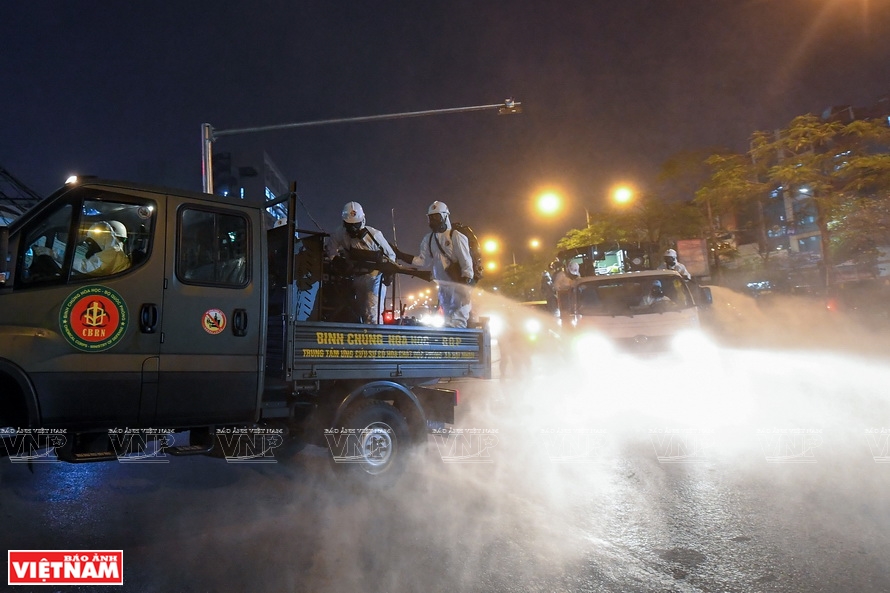
Soldiers from the Vietnam Army’s chemical division disinfect Hanoi’s Bach Mai hospital. Photo: Nguyen Tien Anh Tuan
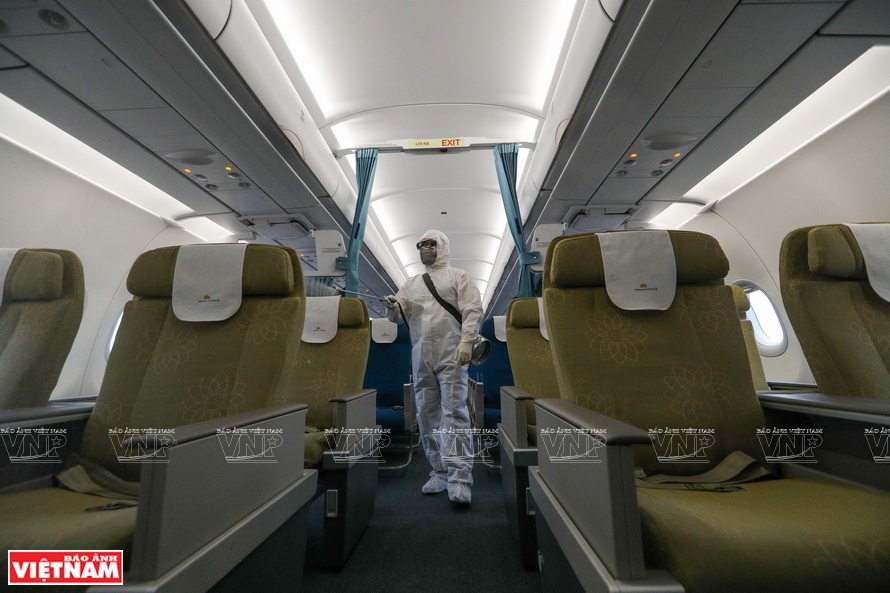
Aircraft are disinfected frequently during the COVID-19. epidemic. Photo: Phong Son
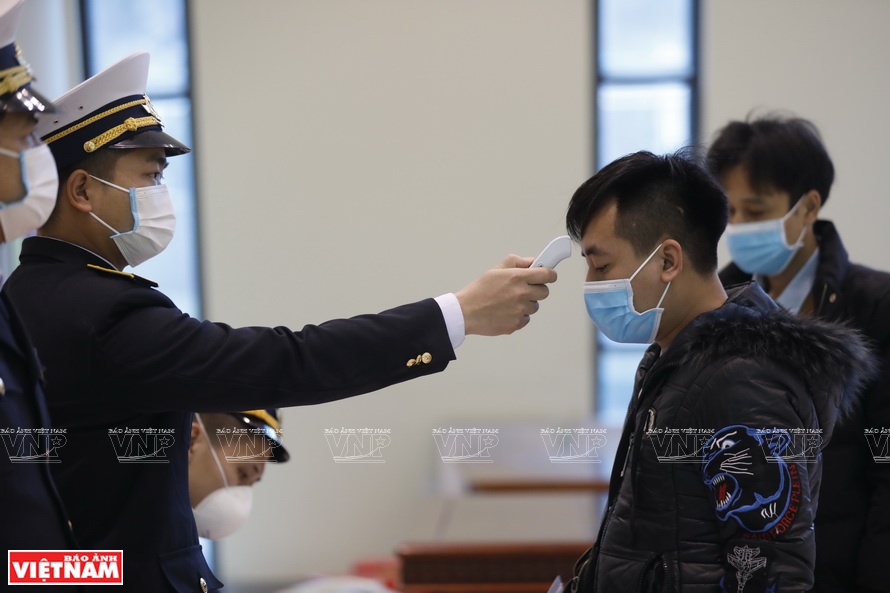
Taking body temperature checks for passengers at Huu Nghi international border gate. Photo: Phong Son
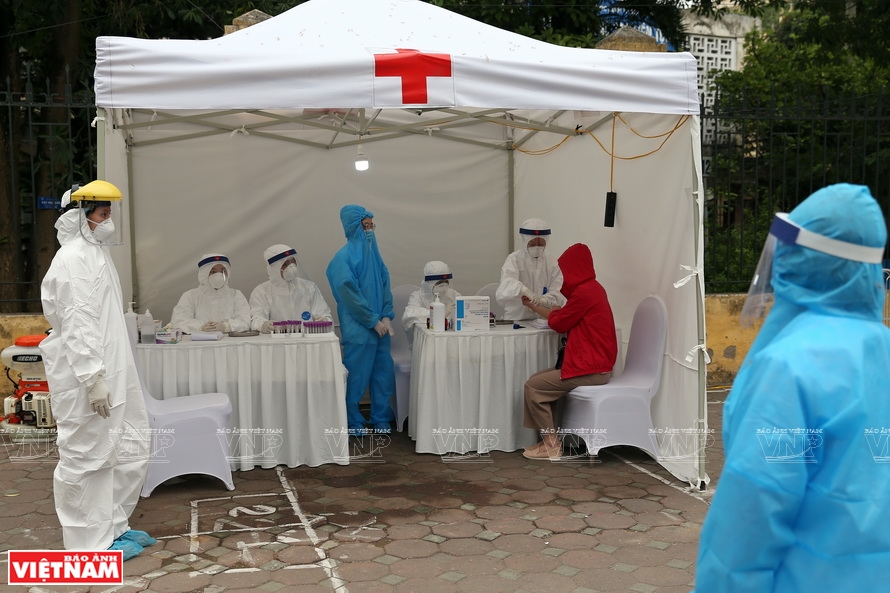
Conducting quick tests for SARS-CoV-2 virus in Hanoi. Photo: Cong Dat / VNP
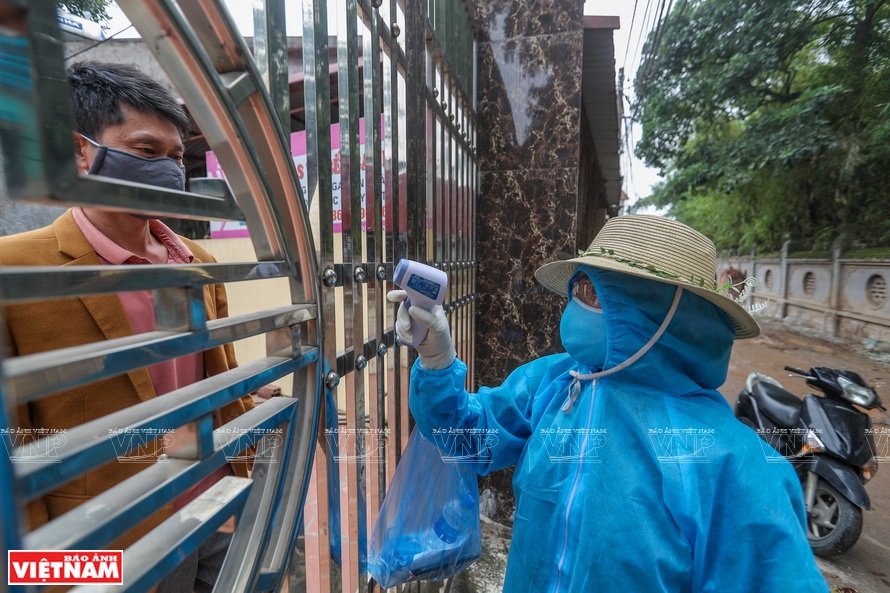
A medical worker checks the temperature of a resident in Ha Loi village in Me Linh district, Hanoi. Photo: Phong Son
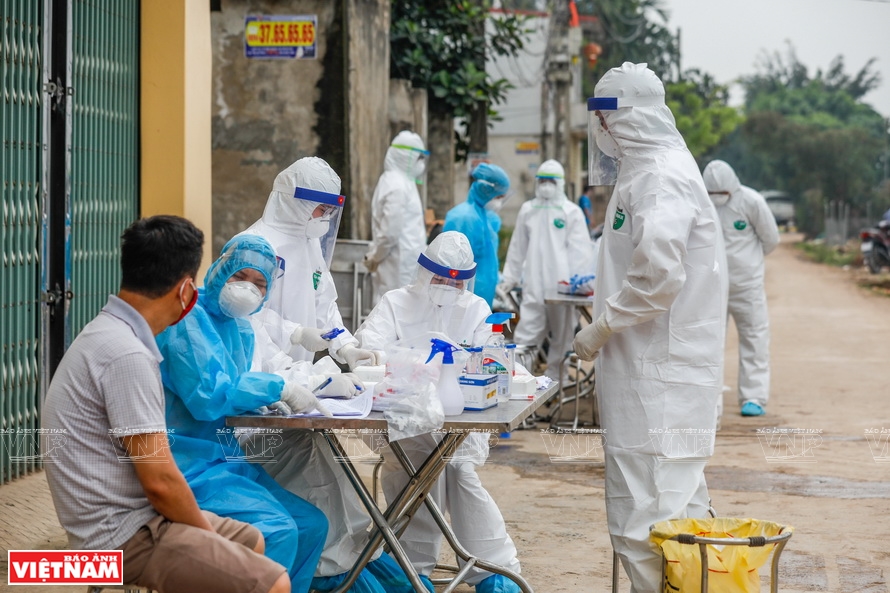
Checking the epidemiological history for Ha Loi villagers. Photo: Phong Son
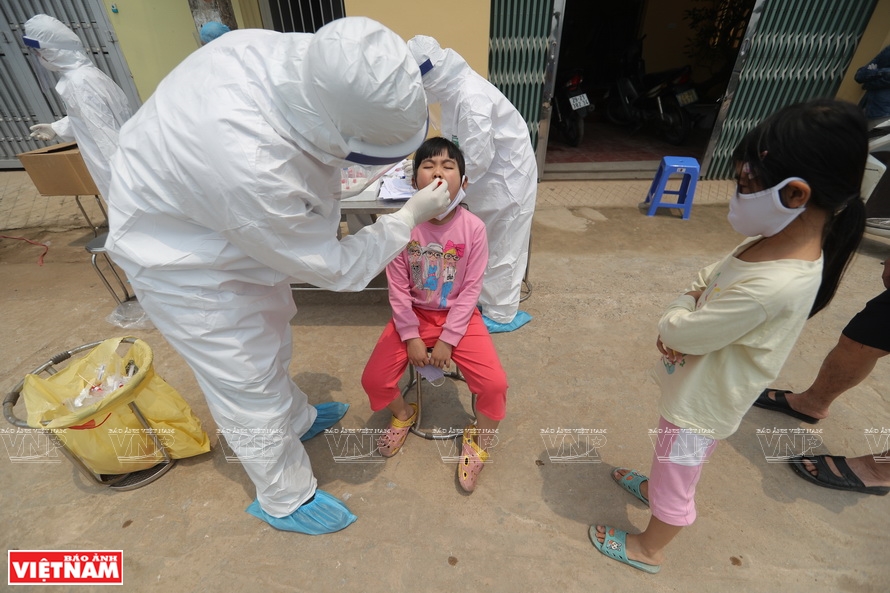
A medical employee takes samples from a resident in Ha Loi village. Photo: Phong Son
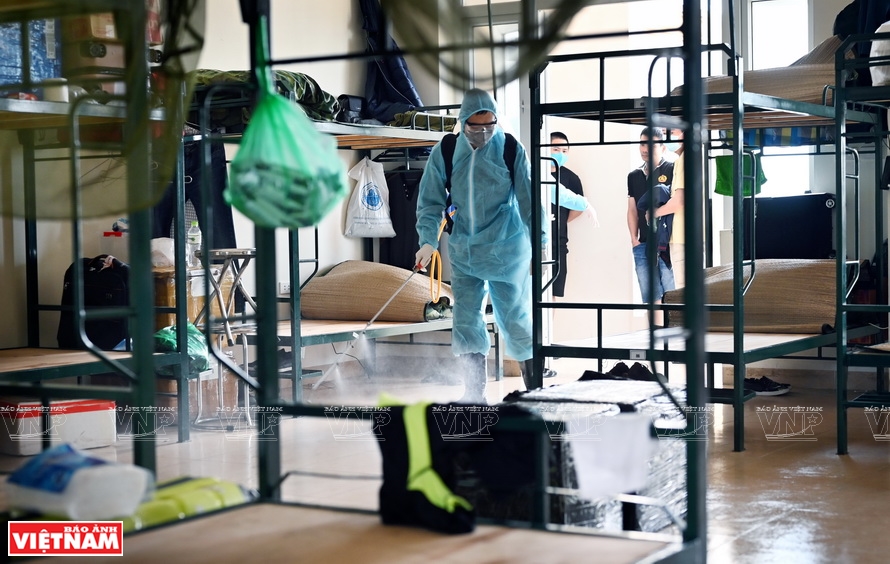
Disinfecting the military school of the Hanoi Capital High Command, which is used for quarantine. Photo: Quoc Viet
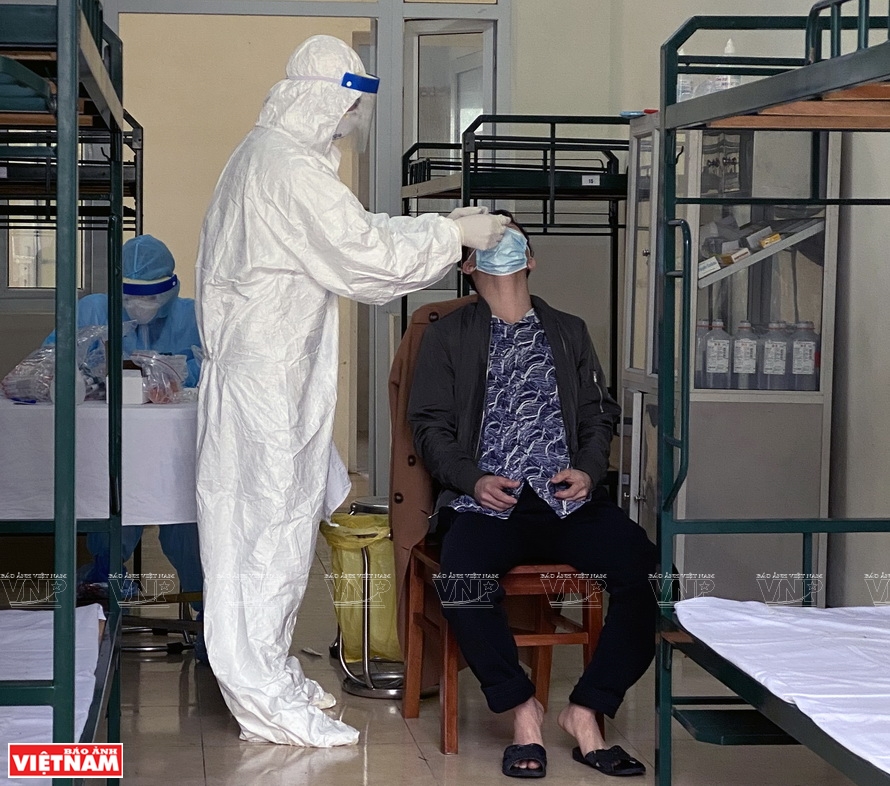
Collecting a patient’s sample for SARS-CoV-2 virus
at the military school of the Hanoi Capital High Command. Photo: Quoc Viet
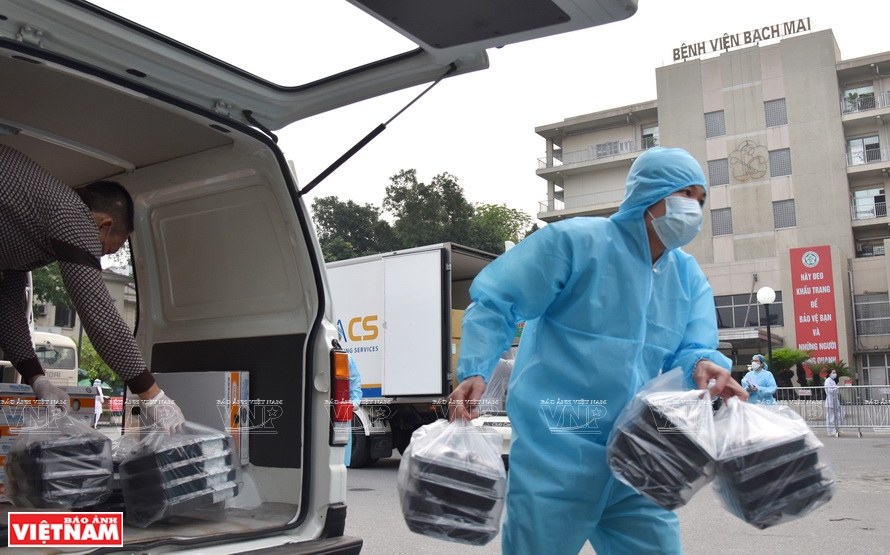
Shipping meals to frontline doctors. Photo: Thanh Giang / VNP

Collecting a patient’s sample for Sars-CoV-2 virus at the military school of the Hanoi Capital High Command. Photo: Quoc Viet
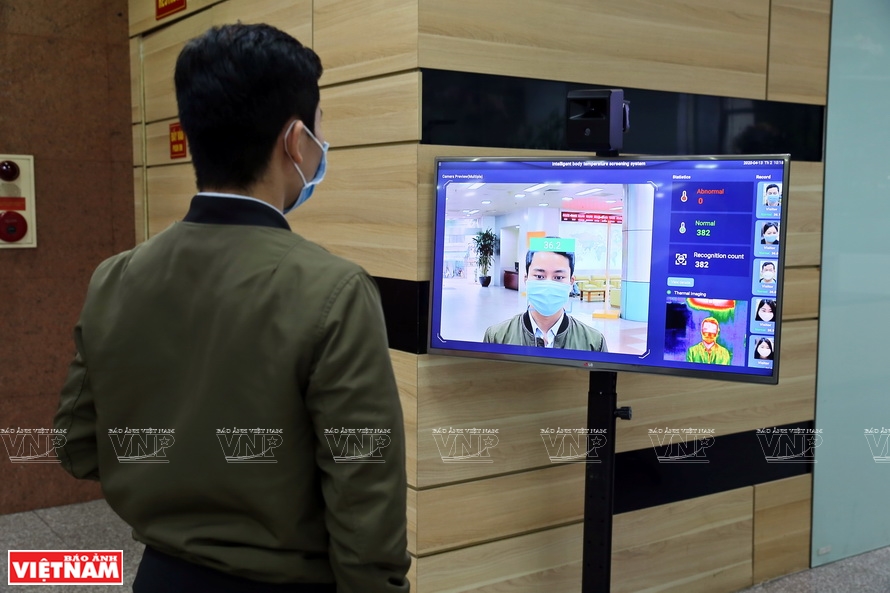
Body thermometers are used at administrative offices in Hanoi. Photo: Cong Dat / VNP
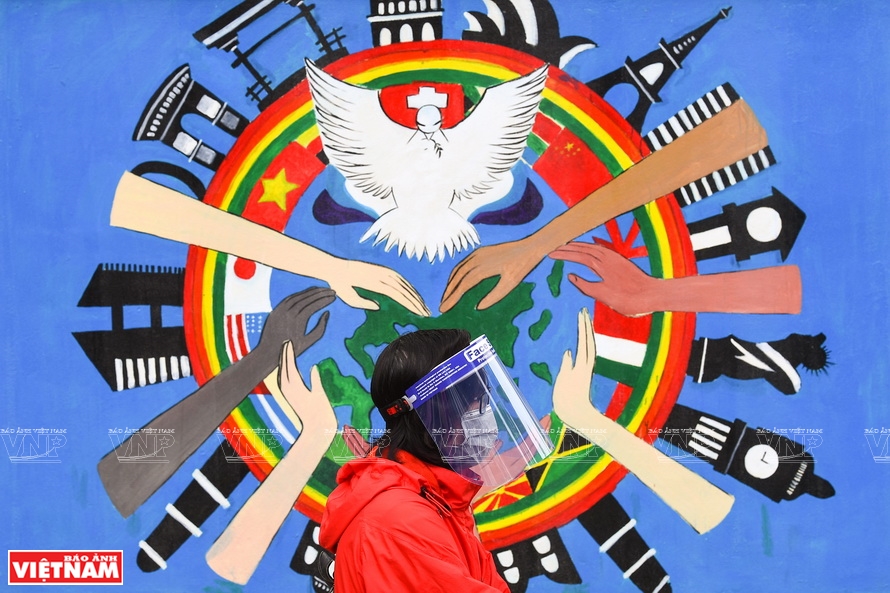
A poster is installed on a street in Hanoi to help Covid-19 fight. Photo: Nguyen Tien Anh Tuan
 Dong Kinh Nghia Thuc square in Hanoi is quiet during social distancing. Photo: Cong Dat / VNP Dong Kinh Nghia Thuc square in Hanoi is quiet during social distancing. Photo: Cong Dat / VNP |
But that was not all. The quarantine was also imposed on residential areas hit by the epidemic. They included Son Loi commune in Binh Xuyen, Vinh Phuc; Truc Bach street in Ba Dinh, Hanoi; Van Lam village 3 in Phuoc Nam commune, Thuan Nam, Ninh Thuan; and Ha Loi village in Me Linh, Hanoi. Bach Mai, the largest hospital in Hanoi, was also locked down after it was identified as a major source of infection.
“Vietnam sets an example for both developing and wealthy countries fighting COVID-19. Much of Vietnam’s success can be ascribed to its social unity.”
Journalist Joshua Hanks wrote in an article posted
on the website “worker.org”.
|
But that was not all. The quarantine was also imposed on residential areas hit by the epidemic. They included Son Loi commune in Binh Xuyen, Vinh Phuc; Truc Bach street in Ba Dinh, Hanoi; Van Lam village 3 in Phuoc Nam commune, Thuan Nam, Ninh Thuan; and Ha Loi village in Me Linh, Hanoi. Bach Mai, the largest hospital in Hanoi, was also locked down after it was identified as a major source of infection.
These mass quarantines meant a huge workload for the army and police forces.
The army and police were not alone in this battle. Their work has been much appreciated by the Vietnamese people who have strongly backed the government in combatting the disease and readily made contributions in their own way.
Supporting the government’s quarantine, people were willing to scarify their economic benefits to prevent the spread of the disease. “At the time of isolation, Ha Loi village had 100 hectares of flowers that needed to be harvested. Instead, we had to cut and throw them away because we understood that epidemic regulations, and quarantines and social distancing should be enforced for the sake of the whole community,” said Pham Van Them, a flower grower in Ha Loi village.
People from all walks of life, old and young alike, had their own way to support the fight against the epidemic.
Tran Bao Ngan, 7, and her sister, Tran Bao Tran, 6, from Thai Hoa town, Nghe An province, smashed their piggy bank to donate over 14 million dong (roughly 350 US dollars) for the fight against Covid-19 at the General Hospital of Northwest Nghe An.
Vu Thi Sim, 103, from Quang Ninh, supported the provincial Covid-19 prevention and control fund with one million dong (over 40 US dollars), which she earned from collecting waste paper and plastic botles.
Hoang Anh Tuan from Ho Chi Minh City invented a rice ATM to provide free rice for thousands of local people hard-hit by the pandemic.
The above people were only a few among more than 100 million Vietnamese people each of whom was a soldier accompanying the government in the fight.
This was shown in the result of a survey conducted by the Berlin-based Dalia Research in 45 countries and territories around the world. The survey found that “the majority of respondents in Vietnam said that the government is doing the right amount of actions in response to the pandemic.” With these responses, the Vietnamese people’s confidence in the government’s handling ranks the highest worldwide.
Vietnam’s efforts to contain the epidemic have also been valued by many foreigners visiting the country during this unusual time. Joanna Zythowska, a Polish tourist in quarantine in Hoi An, wrote a thank-you letter to the police of Quang Nam province which read “You have risked your lives to take care of us. Vietnam will be in my heart forever.”
“White coat soldiers” on the frontline
As early as December 2019, Dr. Le Thi Quynh Mai, Deputy Director of the National Institute of Hygiene and Epidemiology (NIHE), contacted laboratories around the world to track information on the coronavirus disease. When a specimen of the virus was sent to Vietnam late last December, Dr. Mai was ready to “fight the virus.”
Dr. Mai and her colleagues at NIHE successfully cultivated and isolated the severe acute respiratory syndrome coronavirus 2 (SARS-CoV-2) in the laboratory just two months later. This made Vietnam the fourth country to reach this achievement, which opened prospects for developing vaccines against the virus and treatment of the disease.
“This virus is our opponent,” said Doctor Nguyen Trung Cap, head of the Emergency Department at the National Hospital for Tropical Diseases, where more than 100 COVID-19 patients were treated. “We try our best to treat COVID-19 patients, given the advantage that the number of patients in Vietnam was relatively small compared to many countries. This is thanks to the government’s efforts to prevent the spread of the disease from outside and within the country,” he added.
Cap was among thousands of frontline doctors, nurses and medical workers who had not gone home for months, working round the clock to cure COVID-19 victims.
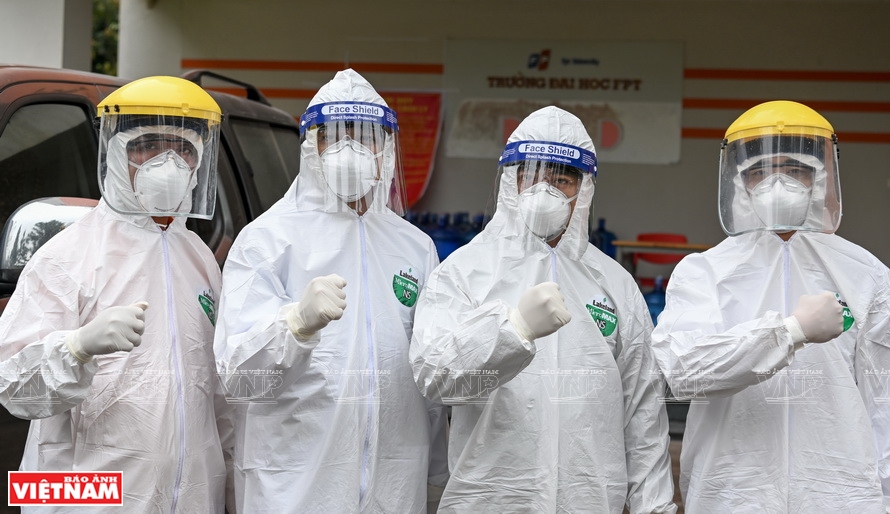
Doctors on the frontline are ready to fight COVID-19. Photo: Nguyen Tien Anh Tuan
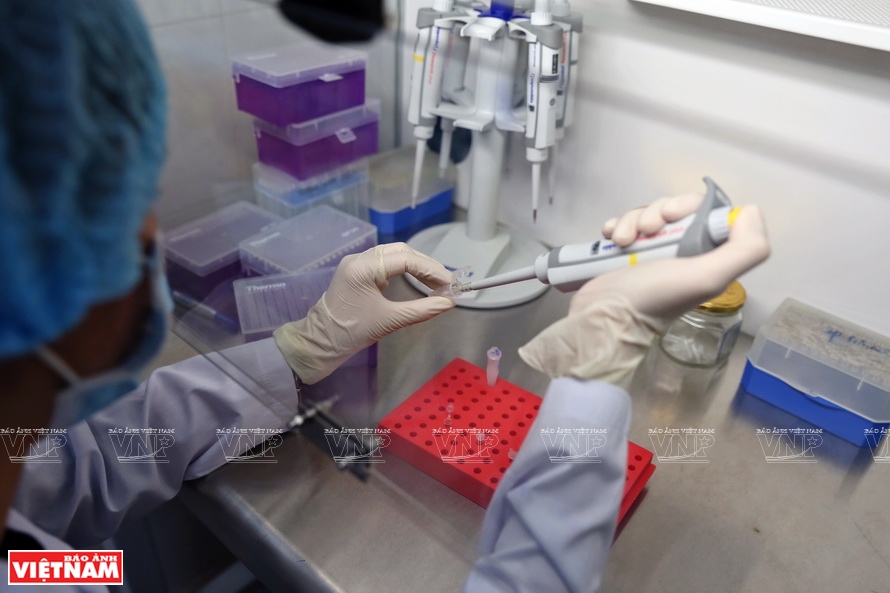
The “made in Vietnam” SARS-CoV-2 test kits are successfully manufactured. Photo: Cong Dat / VNP
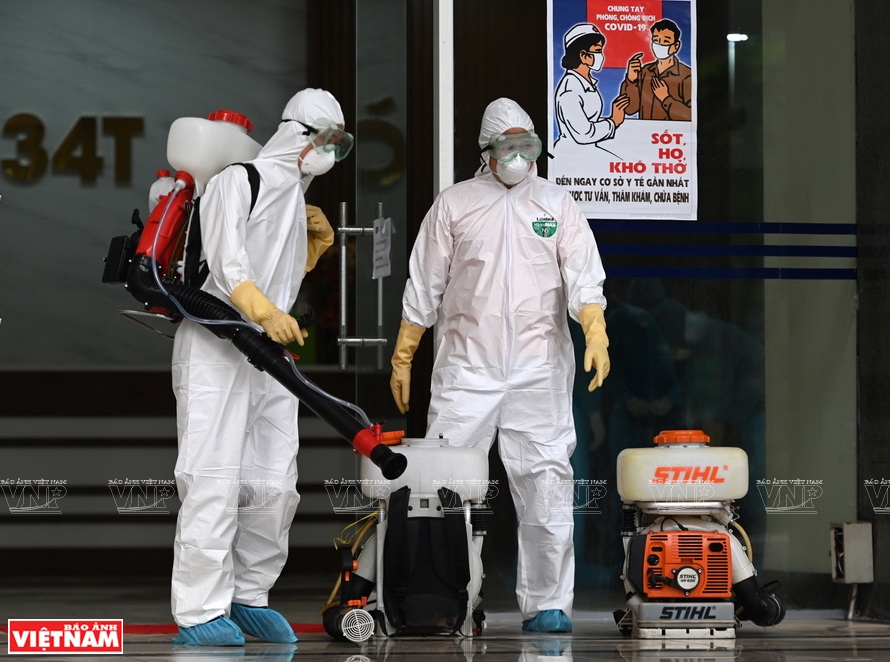
Disinfection is carried out regularly in hospitals treating COVID-19 infected patients nationwide. Photo: Nguyen Tien Anh Tuan
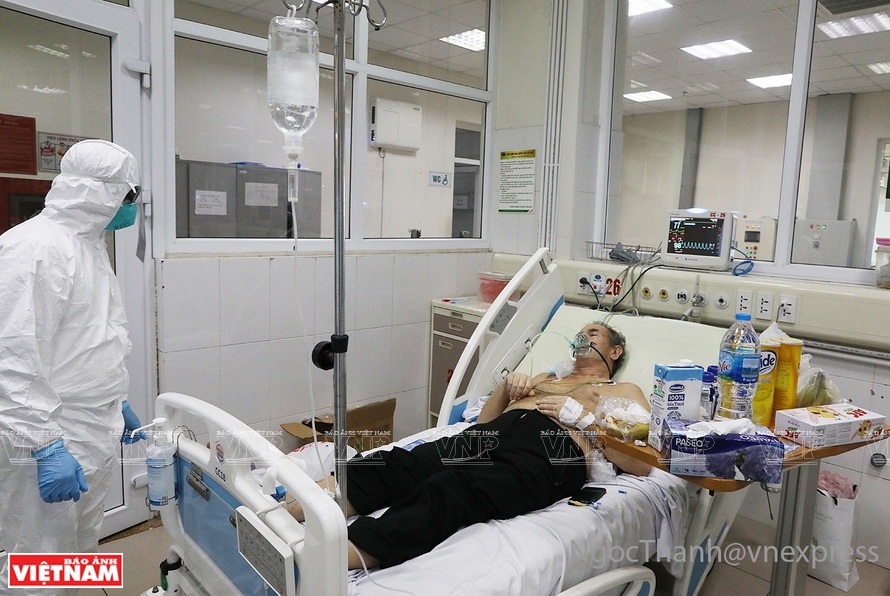
Taking care of a COVID-19 patient at the National Hospital for Tropical Diseases. Photo: Ngoc Thanh

Showing students at Hanoi Medical University how to do anti-COVID-19 exercises. Photo: Cong Dat / VNP
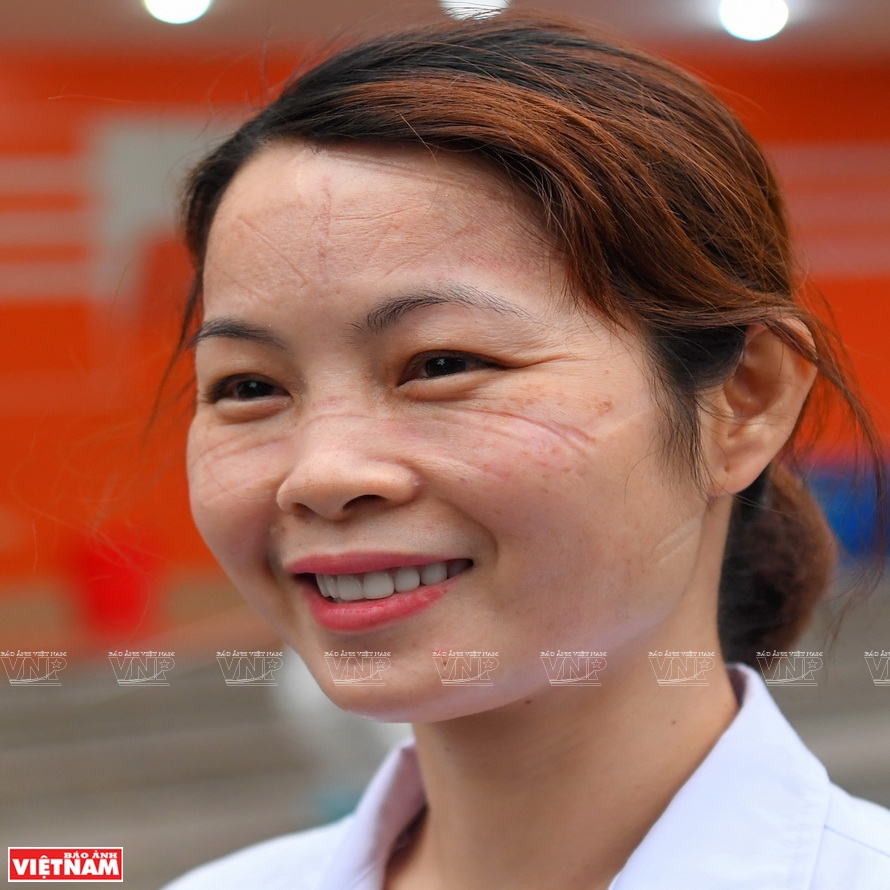
Medical worker Nguyen Thanh Binh has deep facial creases after wearing masks
for 4 hours at the quarantine site at FPT University, Hanoi. Photo: Nguyen Tien Anh Tuan
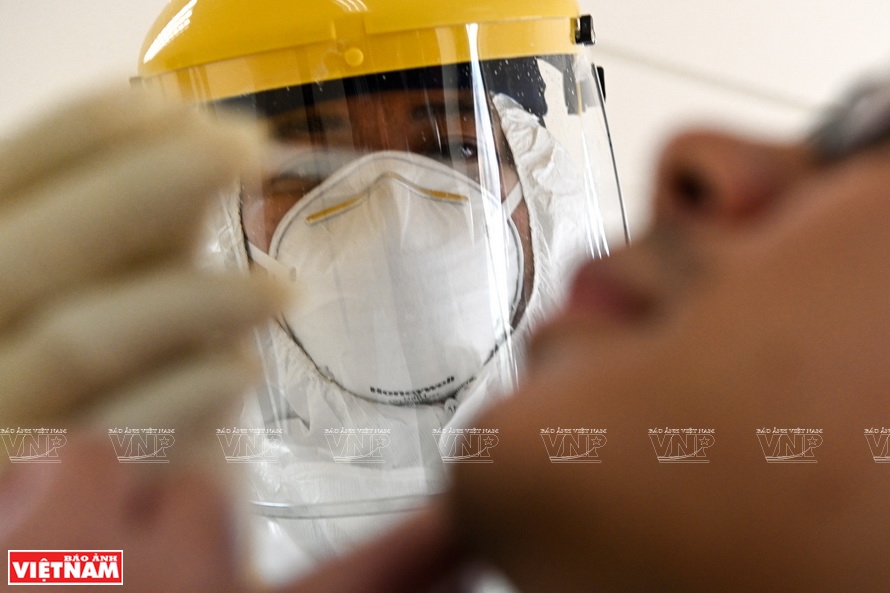
Medical workers take infection risks because they have to take patients’ samples for testing. Photo: Nguyen Tien Anh Tuan
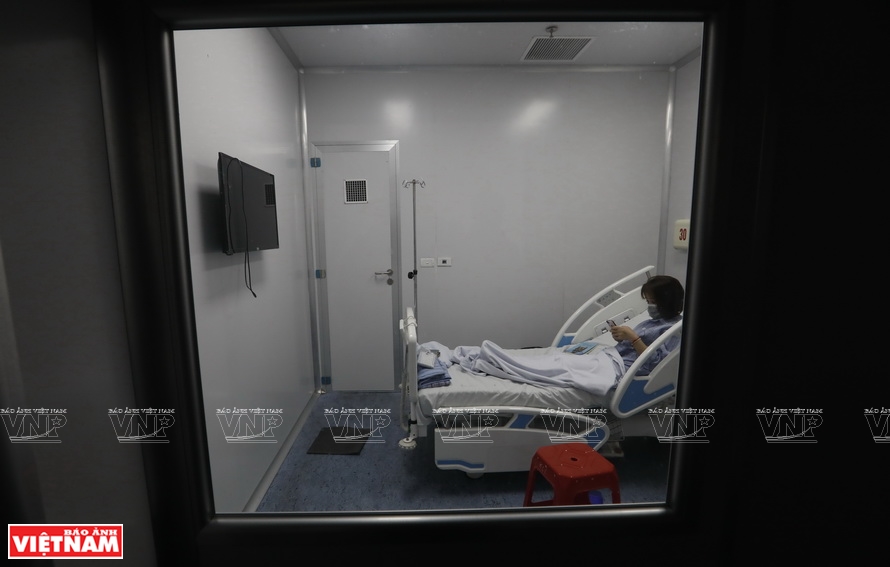
A patient is under special care at the negative pressure room in the National Hospital for Tropical Diseases. Photo: Phong Son
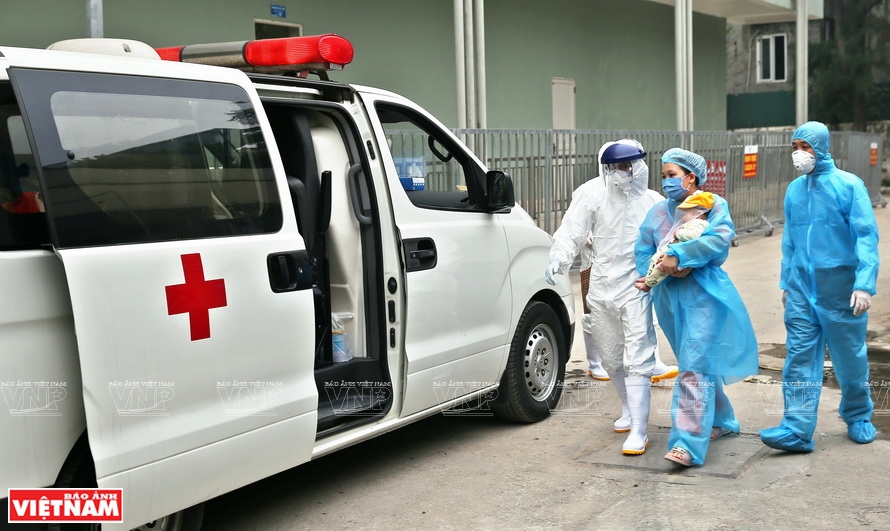
The youngest COVID-19. patient in Vietnam is discharged from the hospital. Photo: Cong Dat / VNP

COVID-19 patients are happy on the day they recover and are discharged from the hospital. Photo: Phong Son |
|
By May 4, Vietnam had reported 271 COVID-19. patients of whom 219 were discharged from the hospital. The country ranked 96th in the world in the number of infections and was one of three countries to have more than 200 infections with no deaths. |
Doctor Luu Nguyen Thang at NIHE’s Infectious Disease Department said his workload had tripled since the COVID-19. outbreak.
Since the start of the epidemic, the staff at Hanoi’s 115 Emergency Center hardly had a complete meal as they had to handle some 1,000 calls each day.
Amid the days of lockdown at Bach Mai hospital, the doctors created a miracle after saving the life of a 30-year-old pregnant woman who suffered hypovolemic shock, serious coagulation disorders, organ failure after a hysterectomy caused by placental abruption and suspected amniotic fluid embolism. The patient was saved without suffering a brain injury even though she suffered cardiac arrest for two hours.
The work of medical workers during the epidemic was summarized by doctor Le Quoc Hung, head of the Tropical Disease Department of Cho Ray hospital in Ho Chi Minh City “A place where an epidemic occurs will be avoided by people, but will be where health workers come.”
Doctors Cap, Hung and Thang, and the staff of Bach Mai hospital represented the will of thousands of doctors, nurses, medical workers and the entire population of Vietnam to contain and beat the Covid-19 pandemic.
“Vietnam has shown strong government leadership in implementing measures to contain the virus. The country has devised an appropriate plan and implemented it in accordance with what was anticipated in each phase.”
Takeshi Kasai WHO Regional Director for the Western Pacific
|
Story: Phong Thu
Photos: Nguyen Tien Anh Tuan, Cong Dat,
Phong Son, Ngoc Thanh, Quoc Viet & Thanh Gian
Translated by Hong Hanh